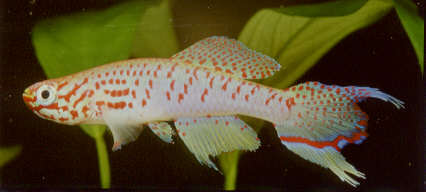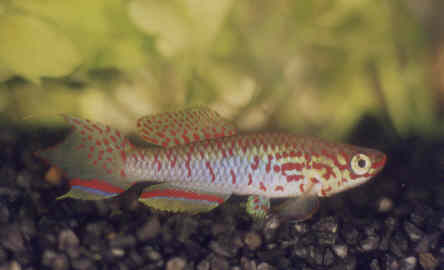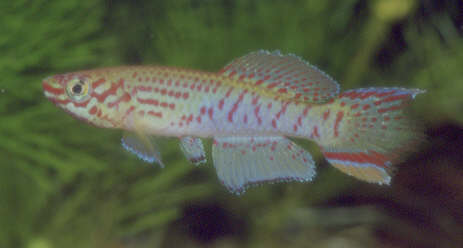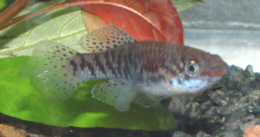Fundulopanchax rubrolabialis (Radda 1973)
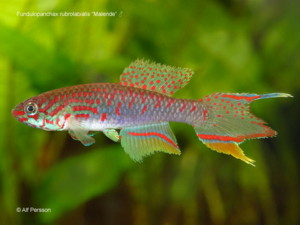
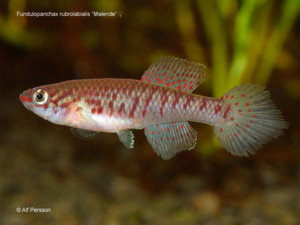
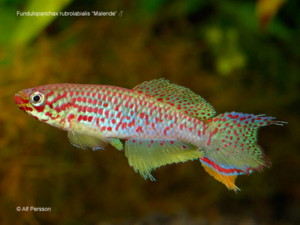
Photos showing 2 forms of the Malende population
with female on the right.
Photos courtesy of Alf & Anita Persson. See
their website
| Meaning of Name |
Refers to the red lip on the lower jaw. |
||||||||||||
| First Description |
Radda A.C. 1973. (Aphyosemion rubrolabiale). Vorläufige Beschreibung von Aphyosemion marmoratum nov. spec. und Aphyosemion rubrolabiale nov. spec. aus Westkamerun. Aquaria 20: p 184-188, figure, map. |
||||||||||||
| Size |
5 cm |
||||||||||||
| Meristics |
D = 17-18, A = 18-19, D/A = 3/1, ll = 27-28 +2 (Radda 1973) |
||||||||||||
| Karyotype |
n = 22-23, A = 30-31 (Scheel 1974) variable between populations. |
||||||||||||
| Sub-Genus |
Paludopanchax |
||||||||||||
| Group |
|
||||||||||||
| Synonyms |
|
||||||||||||
Populations
|
|
||||||||||||
| Type Locality |
19 km northwest of Mbonge, western Cameroon. The biotope was given as 'loamy residual pools of a swampy area'. |
||||||||||||
| Distribution |
Found in the Mémé, Moko & Mungo River drainage systems of western Cameroon. Distribution is apparently restricted to biotopes on sedimentary soils. |
||||||||||||
| Habitat |
Dr.A.C.Radda found them in 3 localities, the area of Mbonge & offshoots of a river with a low water level & gentle flow situated 1·4 km west of the Mungo River on the road from Douala to Victoria. He reported finding 2 examples with a red band in the mid area of the anal fin & 1 example of a specimen with an incomplete band. Raffia swamps, temporary pools & swampy parts of slow flowing brooks in humid coastal rainforest. See Link for additional information. |
||||||||||||
| Distinguishing Characteristics |
See Fp.robertsoni. |
||||||||||||
| Colour/Pattern Variability | Low - medium. Main variability in the anal fin. | ||||||||||||
| History |
Collected by Dr.A.C.Radda in November 1973 in the area of Mbonge + two other localities. |
||||||||||||
| Breeding Notes |
Regarded as a difficult species to breed. A peat substrate has been used succesfully. This is taken out every couple of weeks & dried. Dry incubation takes around 3 months. Fry on hatching can take newly hatched brine shrimp. Growth is a little slow with sexual maturity being attained around 5-6 months. A tip from an article in the BKA newsletter No.184, December 1980 regarding fish reluctant to spawn suggested removing water from the breeding setup to fool the fish into thinking the dry season is approaching. |
||||||||||||
| Diameter of Egg | |||||||||||||
| Remarks |
|
